Comparative Analysis of Gully Morphology Extraction Suitability Using Unmanned Aerial Vehicle and Google Earth Imagery
Abstract
:1. Introduction
2. Materials and Methods
2.1. Study Area
2.2. Field Measurement of Gully
2.3. UAV Aerial Photogrammetry and GE Image Preprocessing
2.4. Method of Interpretation of Gully Shape Parameters
2.5. Gully Morphological Indexes and Calculation Methods
2.6. Error Evaluation Indexes
3. Results
3.1. Gully Morphologies in Different Terrain Regions
3.2. Analysis of the Positioning Error of the Gully Head Points
3.3. Analysis of Gully Length and Width Interpreting Errors
3.4. Analysis of Gully Perimeter and Area Interpretation Errors
4. Discussion
4.1. Explanation of the Correlation between Remote Sensing Image Selection and Gully Morphology
4.2. Characteristics and Limitations of Gully Morphological Parameter Interpretation Using UAV and GE Images
4.3. Future Research
5. Conclusions
Author Contributions
Funding
Data Availability Statement
Conflicts of Interest
Appendix A
| ID | L/m | W/m | P/m | A/m2 | D/m | L/W | W/D | SI | CSA/m2 | |
|---|---|---|---|---|---|---|---|---|---|---|
| Loess gully (n = 32) | 01 | 109.98 | 13.00 | 248.20 | 1269.53 | 4.85 | 8.47 | 2.68 | 1.74 | 39.18 |
| 02 | 42.02 | 16.69 | 120.20 | 622.28 | 9.50 | 2.52 | 1.76 | 1.20 | 91.25 | |
| 03 | 66.34 | 27.70 | 202.39 | 1723.71 | 13.47 | 2.40 | 2.06 | 1.22 | 250.97 | |
| 04 | 83.66 | 24.70 | 229.22 | 1915.36 | 11.63 | 3.39 | 2.12 | 1.31 | 219.34 | |
| 05 | 59.06 | 9.97 | 151.40 | 605.16 | 5.36 | 5.92 | 1.86 | 1.54 | 32.30 | |
| 06 | 82.97 | 25.99 | 197.04 | 1800.92 | 9.08 | 3.19 | 2.86 | 1.16 | 148.45 | |
| 07 | 80.61 | 30.92 | 202.26 | 2213.07 | 11.14 | 2.61 | 2.78 | 1.07 | 231.06 | |
| 08 | 41.78 | 15.26 | 127.44 | 646.77 | 3.88 | 2.73 | 3.93 | 1.25 | 41.69 | |
| 09 | 56.19 | 17.00 | 142.09 | 852.73 | 7.05 | 3.31 | 2.41 | 1.22 | 79.11 | |
| 10 | 30.81 | 11.14 | 78.40 | 312.50 | 5.66 | 2.76 | 1.97 | 1.11 | 40.00 | |
| 11 | 47.00 | 27.78 | 159.99 | 1221.17 | 11.27 | 1.69 | 2.47 | 1.14 | 179.49 | |
| 12 | 69.62 | 16.38 | 156.33 | 972.23 | 4.98 | 4.25 | 3.29 | 1.25 | 51.07 | |
| 13 | 54.53 | 15.28 | 135.22 | 765.74 | 4.69 | 3.57 | 3.26 | 1.22 | 46.50 | |
| 14 | 73.90 | 18.27 | 202.72 | 1287.02 | 8.88 | 4.04 | 2.06 | 1.41 | 106.27 | |
| 15 | 55.33 | 17.19 | 145.05 | 862.39 | 5.05 | 3.22 | 3.40 | 1.23 | 58.99 | |
| 16 | 53.47 | 17.58 | 137.86 | 888.61 | 5.90 | 3.04 | 2.98 | 1.16 | 59.35 | |
| 17 | 35.44 | 16.18 | 91.03 | 493.56 | 8.71 | 2.19 | 1.86 | 1.02 | 82.54 | |
| 18 | 20.35 | 9.33 | 52.73 | 160.65 | 5.52 | 2.18 | 1.69 | 1.04 | 31.78 | |
| 19 | 33.72 | 11.05 | 91.59 | 362.65 | 4.79 | 3.05 | 2.31 | 1.20 | 30.78 | |
| 20 | 47.95 | 15.58 | 117.82 | 568.90 | 7.26 | 3.08 | 2.15 | 1.23 | 66.00 | |
| 21 | 39.61 | 13.95 | 103.16 | 504.99 | 4.98 | 2.84 | 2.80 | 1.15 | 46.95 | |
| 22 | 39.63 | 11.55 | 93.45 | 417.28 | 4.63 | 3.43 | 2.50 | 1.14 | 30.52 | |
| 23 | 38.38 | 16.18 | 100.71 | 553.53 | 6.51 | 2.37 | 2.49 | 1.07 | 62.64 | |
| 24 | 83.42 | 19.72 | 219.79 | 1359.80 | 11.49 | 4.23 | 1.72 | 1.49 | 127.10 | |
| 25 | 33.08 | 12.14 | 92.11 | 378.03 | 4.88 | 2.72 | 2.49 | 1.18 | 39.64 | |
| 26 | 60.54 | 26.04 | 162.80 | 1388.18 | 10.54 | 2.33 | 2.47 | 1.09 | 184.50 | |
| 27 | 16.57 | 9.13 | 42.10 | 122.37 | 3.69 | 1.82 | 2.47 | 0.95 | 15.92 | |
| 28 | 26.57 | 12.13 | 73.49 | 290.72 | 5.78 | 2.19 | 2.10 | 1.08 | 40.09 | |
| 29 | 36.55 | 1.12 | 78.06 | 46.19 | 0.18 | 32.72 | 6.21 | 2.87 | 0.14 | |
| 30 | 31.97 | 1.35 | 70.93 | 37.26 | 0.19 | 23.76 | 7.23 | 2.90 | 0.17 | |
| 31 | 15.16 | 7.24 | 42.74 | 107.08 | 3.49 | 2.10 | 2.07 | 1.03 | 17.25 | |
| 32 | 21.97 | 9.87 | 55.38 | 183.16 | 9.34 | 2.23 | 1.06 | 1.02 | 58.35 | |
| Black soil gully (n = 7) | 1 | 164.48 | 2.93 | 383.72 | 506.49 | 1.13 | 56.12 | 2.61 | 4.26 | 1.39 |
| 2 | 63.25 | 2.09 | 152.29 | 114.22 | 0.85 | 30.31 | 2.45 | 3.56 | 0.95 | |
| 3 | 206.10 | 2.60 | 431.49 | 538.69 | 0.80 | 79.23 | 3.25 | 4.65 | 1.39 | |
| 4 | 45.15 | 3.45 | 108.12 | 139.44 | 0.88 | 13.07 | 3.93 | 2.29 | 2.34 | |
| 5 | 49.22 | 3.15 | 113.92 | 130.61 | 0.54 | 15.61 | 3.93 | 2.29 | 1.35 | |
| 6 | 50.31 | 4.28 | 108.39 | 187.19 | 0.37 | 11.75 | 11.61 | 1.98 | 0.72 | |
| 7 | 71.67 | 2.25 | 163.50 | 163.51 | 0.49 | 31.85 | 4.62 | 3.20 | 0.78 |
References
- Castillo, C.; Gómez, J.A. A century of gully erosion research: Urgency, complexity and study approaches. Earth-Sci. Rev. 2016, 160, 300–319. [Google Scholar] [CrossRef]
- Vanmaercke, M.; Poesen, J.; Van Mele, B.; Demuzere, M.; Bruynseels, A.; Golosov, V.; Bezerra, J.F.R.; Bolysov, S.; Dvinskih, A.; Frankl, A.; et al. How fast do gully headcuts retreat. Earth-Sci. Rev. 2016, 154, 336–355. [Google Scholar] [CrossRef]
- Li, Y.; Poesen, J.; Yang, J.C.; Fu, B.; Zhang, J.H. Evaluating gully erosion using Cs-137 and Pb-210/Cs-137 ratio in a reservoir catchment. Soil Tillage Res. 2003, 69, 107–115. [Google Scholar] [CrossRef]
- Samani, A.N.; Wasson, R.J.; Malekian, A. Application of multiple sediment fingerprinting techniques to determine the sediment source contribution of gully erosion: Review and case study from Boushehr province, southwestern Iran. Prog. Phys. Geogr. -Earth Environ. 2011, 35, 375–391. [Google Scholar] [CrossRef]
- Zhang, T.Y.; Liu, G.; Duan, X.W.; Wilson, G.V. Spatial distribution and morphologic characteristics of gullies in the Black Soil Region of Northeast China: Hebei watershed. Phys. Geogr. 2016, 37, 228–250. [Google Scholar] [CrossRef]
- Gimenez, R.; Marzolff, I.; Campo, M.A.; Seeger, M.; Ries, J.B.; Casali, J.; Alvarez-Mozos, J. Accuracy of high-resolution photogrammetric measurements of gullies with contrasting morphology. Earth Surf. Process. Landf. 2009, 34, 1915–1926. [Google Scholar] [CrossRef]
- Wu, H.Y.; Xu, X.M.; Zheng, F.L.; Qin, C.; He, X. Gully morphological characteristics in the loess hilly-gully region based on 3D laser scanning technique. Earth Surf. Process. Landf. 2018, 43, 1701–1710. [Google Scholar] [CrossRef]
- Soil Science Society of America. Glossary of Soil Science Terms; Soil Science Society of America: Madison, WI, USA, 2016. [Google Scholar]
- Hauge, C. Soil erosion definitions. Calif. Geo. 1977, 30, 202–203. [Google Scholar]
- Poesen, J.; Vandaele, K.; Van Wesemael, B. Contribution of Gully Erosion to Sediment Production in Cultivated Lands and Rangelands. IAHS Publ. Ser. Proc. Rep. Intern Assoc Hydrol. Sci. 1996, 236, 251–266. [Google Scholar]
- Zhu, H.C.; Tang, G.A.; Qian, K.J.; Liu, H.Y. Extraction and analysis of gully head of Loess Plateau in China based on digital elevation model. Chin. Geogr. Sci. 2014, 24, 328–338. [Google Scholar] [CrossRef]
- Wang, Z.G.; Zhang, G.H.; Wang, C.S.; Xing, S.K. Gully Morphological Characteristics and Topographic Threshold Determined by UA V in a Small Watershed on the Loess Plateau. Remote Sens. 2022, 14, 3529. [Google Scholar] [CrossRef]
- Wu, Y.Q.; Cheng, H. Monitoring of gully erosion on the Loess Plateau of China using a global positioning system. Catena 2005, 63, 154–166. [Google Scholar] [CrossRef]
- Castillo, C.; Perez, R.; James, M.R.; Quinton, J.N.; Taguas, E.V.; Gomez, J.A. Comparing the Accuracy of Several Field Methods for Measuring Gully Erosion. Soil Sci. Soc. Am. 2012, 76, 1319–1332. [Google Scholar] [CrossRef]
- Ionita, I.; Niacsu, L.; Petrovici, G.; Blebea-Apostu, A.M. Gully development in eastern Romania: A case study from Falciu Hills. Nat. Hazards 2015, 79, 113–138. [Google Scholar] [CrossRef]
- Crouch, R.J. Short communications erosion processes and rates for gullies in Granitic soils Bathurst, New South Wales, Australia. Earth Surf. Process Landf. 1990, 15, 169–173. [Google Scholar] [CrossRef]
- Yuan, M.T.; Zhang, Y.; Zhao, Y.Y.; Deng, J.Y. Effect of rainfall gradient and vegetation restoration on gully initiation under a large-scale extreme rainfall event on the hilly Loess Plateau: A case study from the Wuding River basin, China. Sci. Total Environ. 2020, 739, 140066. [Google Scholar] [CrossRef]
- Potere, D. Horizontal Positional Accuracy of Google Earth’s High-Resolution Imagery Archive. Sensors 2008, 8, 7973–7981. [Google Scholar] [CrossRef]
- Na, J.M.; Yang, X.; Tang, G.A.; Dang, W.Q.; Strobl, J. Population Characteristics of Loess Gully System in the Loess Plateau of China. Remote Sens. 2020, 12, 2639. [Google Scholar] [CrossRef]
- Yang, X.; Na, J.M.; Tang, G.A.; Wang, T.T.; Zhu, A.X. Bank gully extraction from DEMs utilizing the geomorphologic features of a loess hilly area in China. Front. Earth Sci. 2019, 13, 151–168. [Google Scholar] [CrossRef]
- Chen, Y.H.; Jiao, J.Y.; Wei, Y.H.; Zhao, H.K.; Yu, W.J.; Cao, B.T.; Xu, H.Y.; Yan, F.C.; Wu, D.Y.; Li, H. Accuracy assessment of the planar morphology of valley bank gullies extracted with high resolution remote sensing imagery on the loess plateau, China. Environ. Res. Public Health 2019, 16, 369. [Google Scholar] [CrossRef]
- Prasad, D.; Sheshukov, A.Y.; Douglas-Mankin, K.R. Evaluating ephemeral gullies with a process-based topographic index model. Catena 2013, 113, 177–186. [Google Scholar]
- Wang, B.W.; Zhang, Z.X.; Wang, X.; Zhao, X.L.; Yi, L.; Hu, S.G. The Suitability of Remote Sensing Images at Different Resolutions for Mapping of Gullies in the Black Soil Region, Northeast China. Remote Sens. 2021, 13, 2367. [Google Scholar] [CrossRef]
- Dai, W.; Yang, X.; Na, J.M.; Li, J.W.; Brus, D.; Xiong, L.Y.; Tang, G.A.; Huang, X.L. Effects of DEM resolution on the accuracy of gully maps in loess hilly areas. Catena 2019, 177, 114–125. [Google Scholar] [CrossRef]
- Pu, L.M.; Zhang, S.W.; Wang, R.H.; Chang, L.P.; Yang, J.C. Analysis of Erosion Gully Information Extraction Based on Muti-resource Remote Sensing Images. Geogr. Geo-Inf. Sci. 2016, 32, 90–94. (In Chinese) [Google Scholar]
- Yan, Y.C.; Zhang, S.W.; Yue, S.P. Classification of Erosion Gullies by Remote Sensing and Spatial Pattern Analysis in Black Soil Region of Eastern Kebai. Sci. Geogr. Sin. 2007, 2, 193–199. (In Chinese) [Google Scholar]
- Zhang, Q.; Zhang, G.H.; Zhang, Y.; Wang, J.X.; Yu, S.W. Accuracy Analysis and Conversion Model of Gully Auto-matic Extraction based on Remote Sensing Images with Different Resolutions. Remote Sens. Technol. Appl. 2022, 37, 1217–1226. (In Chinese) [Google Scholar]
- Guan, Y.B.; Yang, S.T.; Zhao, C.S.; Lou, H.Z.; Chen, K.; Zhang, C.B.; Wu, B.W. Monitoring long-term gully erosion and topographic thresholds in the marginal zone of the Chinese Loess Plateau. Soil Tillage Res. 2021, 205, 104800. [Google Scholar] [CrossRef]
- Li, Z.; Zhang, Y.; Yang, S.; Zhu, Q.K.; Wu, J.H.; Ma, H.; He, Y.M. Error assessment of extracting morphological parameters of bank gullies by manual visual interpretation based on QuickBird imagery. Trans. Chin. Soc. Agric. Eng. 2014, 30, 179–186. (In Chinese) [Google Scholar]
- Yibeltal, M.; Tsunekawa, A.; Haregeweyn, N.; Adgo, E.; Meshesha, D.T.; Masunaga, T.; Tsubo, M.; Billi, P.; Ebabu, K.; Fenta, A.A.; et al. Morphological characteristics and topographic thresholds of gullies in different agro-ecological environments. Geomorphology 2019, 341, 15–27. [Google Scholar] [CrossRef]
- Liu, X.; Wang, C.M.; Pang, G.W.; Long, Y.Q.; Wang, L. Sensitive area simulation of ephemeral and permanent gullies based on slope-area relationship. Mt. Res. 2020, 38, 658–667. (In Chinese) [Google Scholar]
- Wang, R.H.; Zhang, S.W.; Pu, L.M.; Yang, J.C.; Yang, C.B.; Chen, J.; Guan, C.; Wang, Q.; Chen, D.; Fu, B.L.; et al. Gully Erosion Mapping and Monitoring at Multiple Scales Based on Multi-Source Remote Sensing Data of the Sancha River Catchment, Northeast China. ISPRS Int. J. Geo-Inf. 2016, 5, 200. [Google Scholar] [CrossRef]
- Yang, A.N.; Wang, C.M.; Pang, G.W.; Long, Y.Q.; Wang, L.; Cruse, R.M.; Yang, Q.K. Gully Erosion Susceptibility Mapping in Highly Complex Terrain Using Machine Learning Models. ISPRS Int. J. Geo-Inf. 2021, 10, 680. [Google Scholar] [CrossRef]
- Frankl, A.; Zwertvaegher, A.; Poesen, J.; Nyssen, J. Transferring Google Earth observations to GIS-software: Example from gully erosion study. Int. J. Digit. Earth 2013, 6, 196–201. [Google Scholar] [CrossRef]
- Yang, L.J.; Wang, C.M.; Zhang, C.M.; Pang, G.W.; Long, Y.Q.; Wang, L.; Liu, B.Y.; Yang, Q.K. Occurrence and development of newly formed gullies under extreme rainstorm conditions using remote sensing images. Trans. Chin. Soc. Agric. Eng. 2022, 38, 96–104. (In Chinese) [Google Scholar]
- Li, Z.; Qin, W.; Qi, Z.G.; Shang, G.F.; Ma, Q.T.; Guo, Q.K.; Yin, Z. Remote sensing analysis on gully morphology and spatial distribution in rolling hilly region and mountainous and hilly region of Northeast China. Trans. Chin. Soc. Agric. Eng. 2019, 35, 133–140. (In Chinese) [Google Scholar]
- Wu, J.G. Landscape Ecology Pattern, Process, Scale and Hierachy; Higher Education Press: Beijing, China, 2000; p. 107. (In Chinese) [Google Scholar]
- Li, Z.G.; Wang, Y.S.; Liu, X.C.; Liu, J.X. Survey methods and results of erosion gullies in black soil areas of northeastern China. Sci. Soil Water Conserv. 2013, 11, 9–13. (In Chinese) [Google Scholar]
- Piacentini, T.; Galli, A.; Marsala, V.; Miccadei, E. Analysis of Soil Erosion Induced by Heavy Rainfall: A Case Study from the NE Abruzzo Hills Area in Central Italy. Water 2018, 10, 1314. [Google Scholar] [CrossRef]
- Lou, H.Z.; Wang, P.F.; Yang, S.T.; Hao, F.H.; Ren, X.Y.; Wang, Y.; Shi, L.H.; Wang, J.; Gong, T.L. Combining and Comparing an Unmanned Aerial Vehicle and Multiple Remote Sensing Satellites to Calculate Long-Term River Discharge in an Ungauged Water Source Region on the Tibetan Plateau. Remote Sens. 2020, 12, 2155. [Google Scholar] [CrossRef]
- Frankl, A.; Stal, C.; Abraha, A.; Nyssen, J.; Rieke-Zapp, D.; De Wulf, A.; Poesen, J. Detailed recording of gully morphology in 3D through image-based modelling. Catena 2015, 127, 92–101. [Google Scholar] [CrossRef]
- Song, X.P.; Zhang, Y.; Wang, Z.Q.; Deng, J.Y.; Wang, J.X. Accuracy of gully morphological parameters extracted by UAV photogrammetry in the Loess Plateau. J. Beijing Norm. Univ. 2021, 57, 606–612. (In Chinese) [Google Scholar]
- Anderson, C.J. Comparing the Slope-Area Threshold for Stream Initiation in Primeval and Managed Forests of Northern Michigan. For. Sci. 2020, 66, 130–139. [Google Scholar] [CrossRef]
- Singh, B.M. Interpretation of satellite imagery for delineation of ravines. J. Indian Soc. Photo-Interpret. 1977, 5, 31–34. [Google Scholar] [CrossRef]
- Wang, C.M.; Cruse, R.M.; Gelder, B.; James, D.; Liu, X. Grid order prediction of ephemeral gully head cut position: Regional scale application. Catena 2021, 200, 105158. [Google Scholar] [CrossRef]
- Li, Z.; Zhang, Y.; Zhu, Q.K.; Yang, S.; Li, H.J.; Ma, H. A gully erosion assessment model for the Chinese Loess Plateau based on changes in gully length and area. Catena 2017, 148, 195–203. [Google Scholar] [CrossRef]
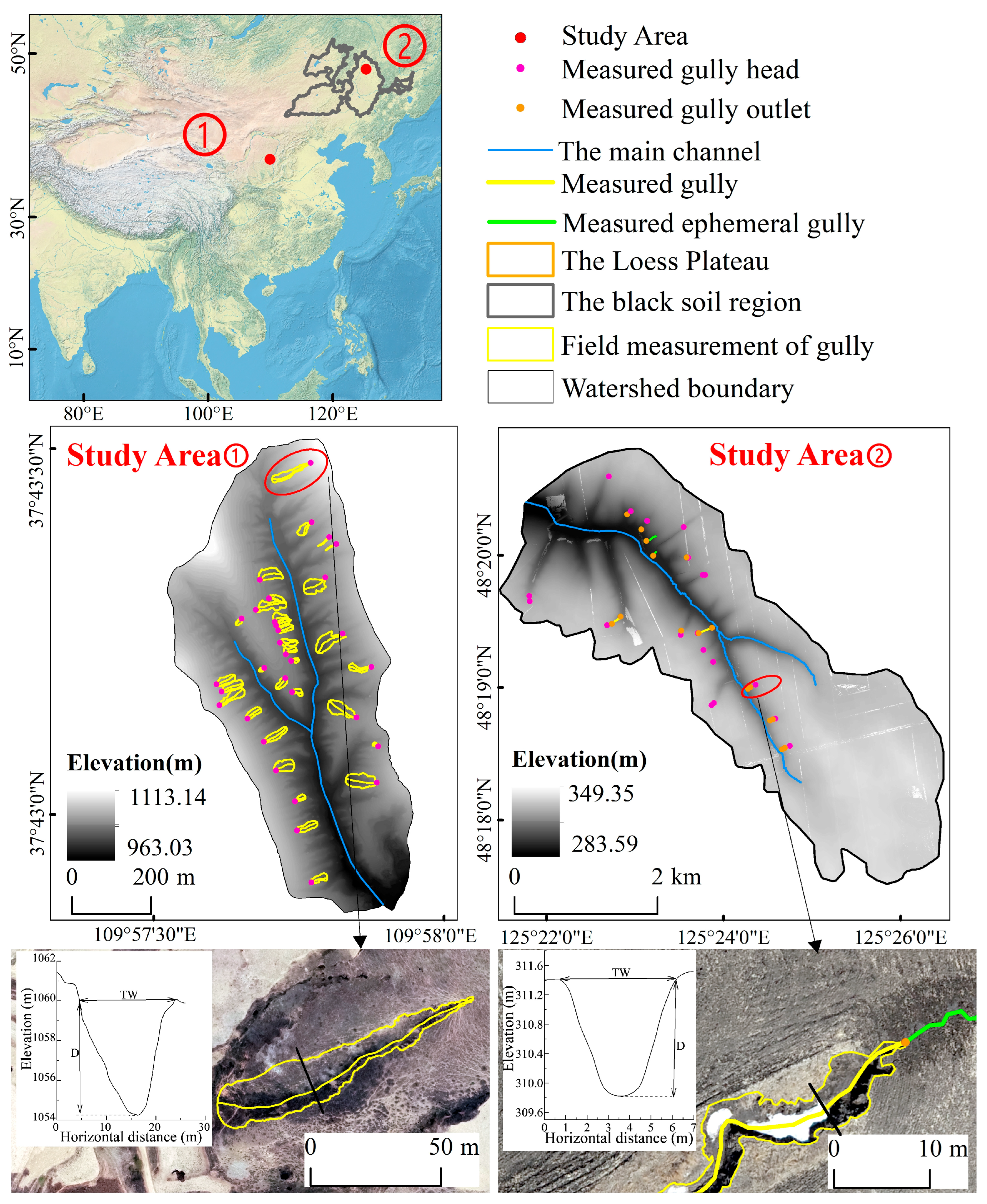


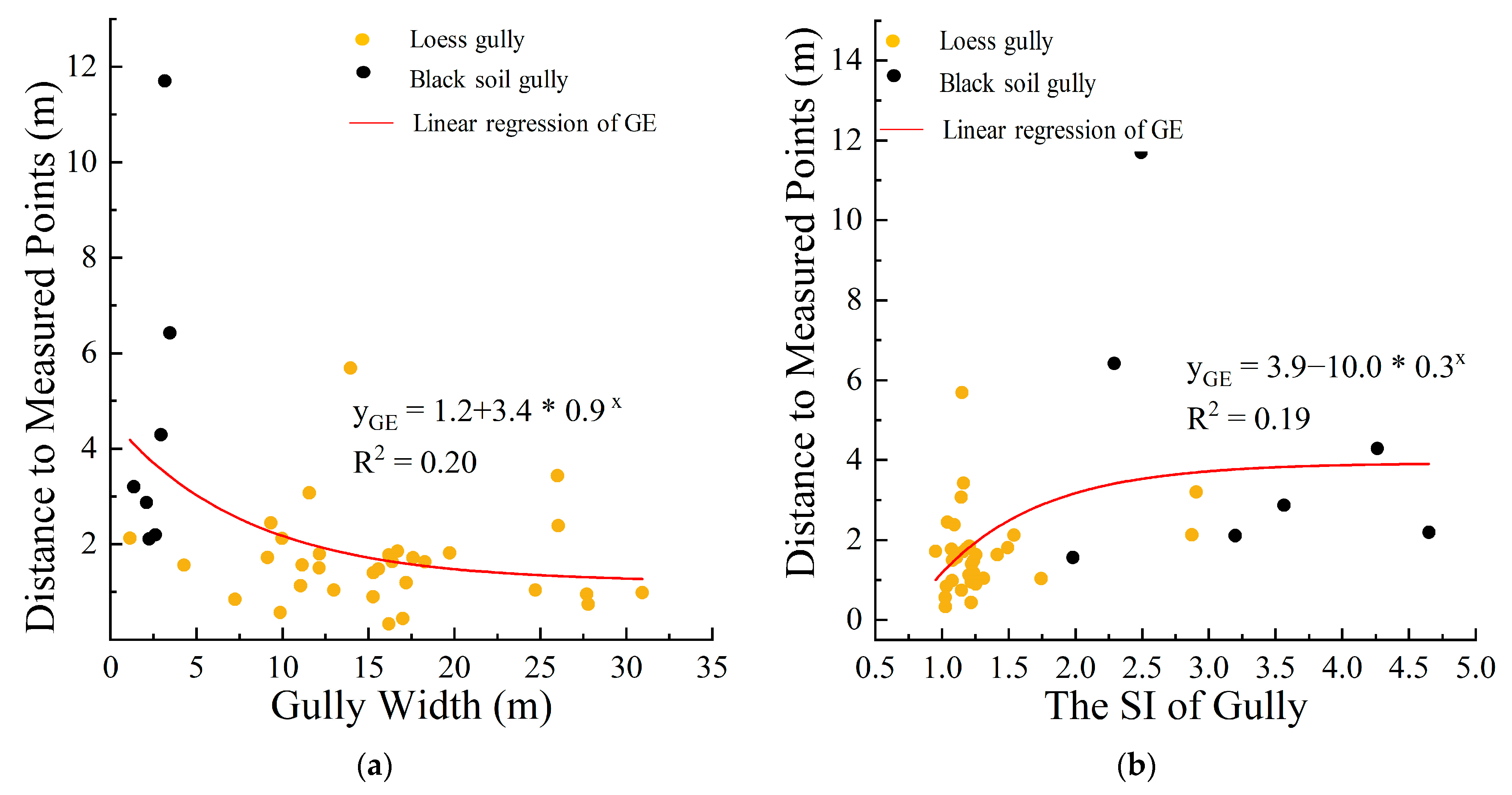
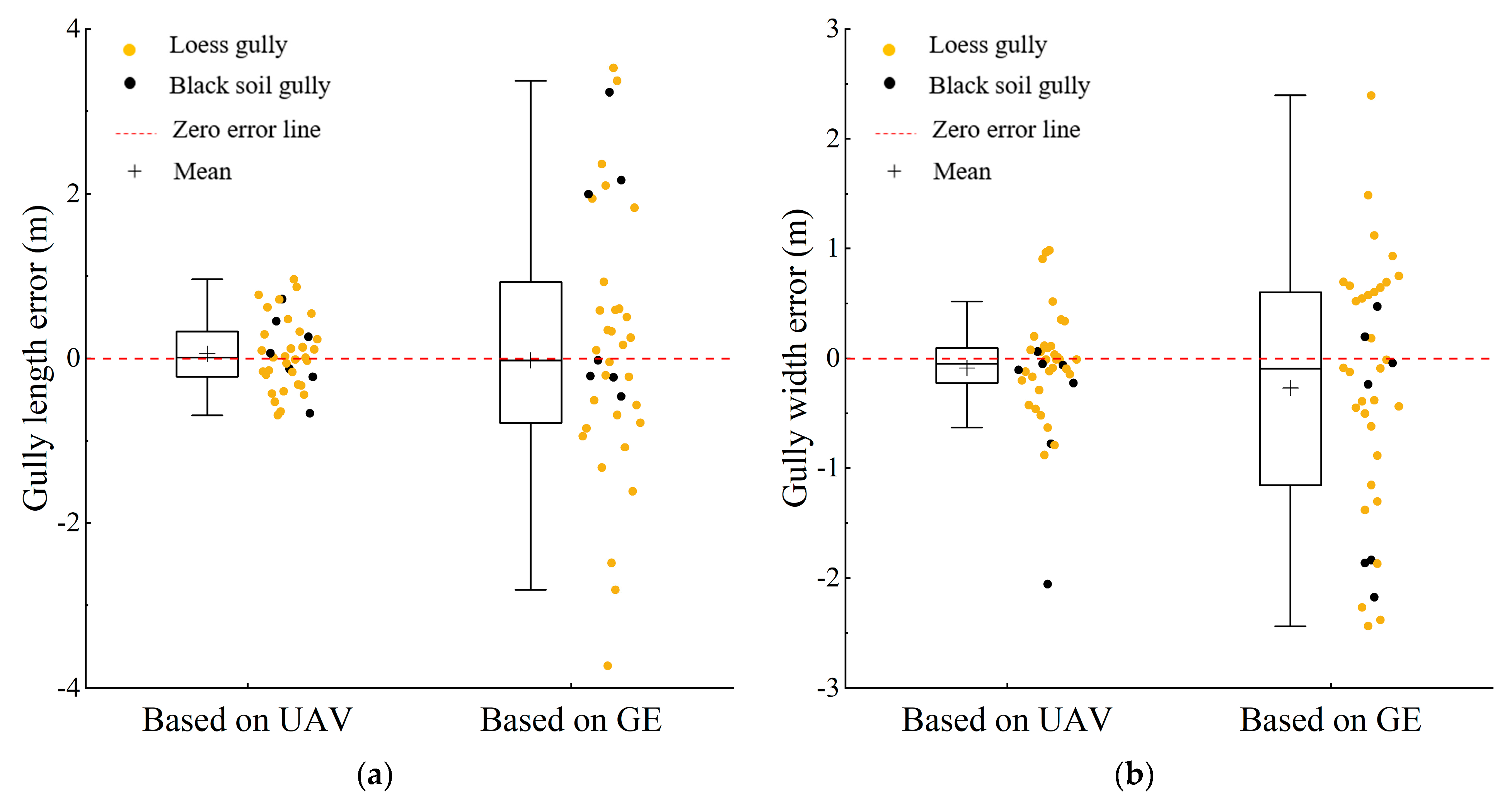
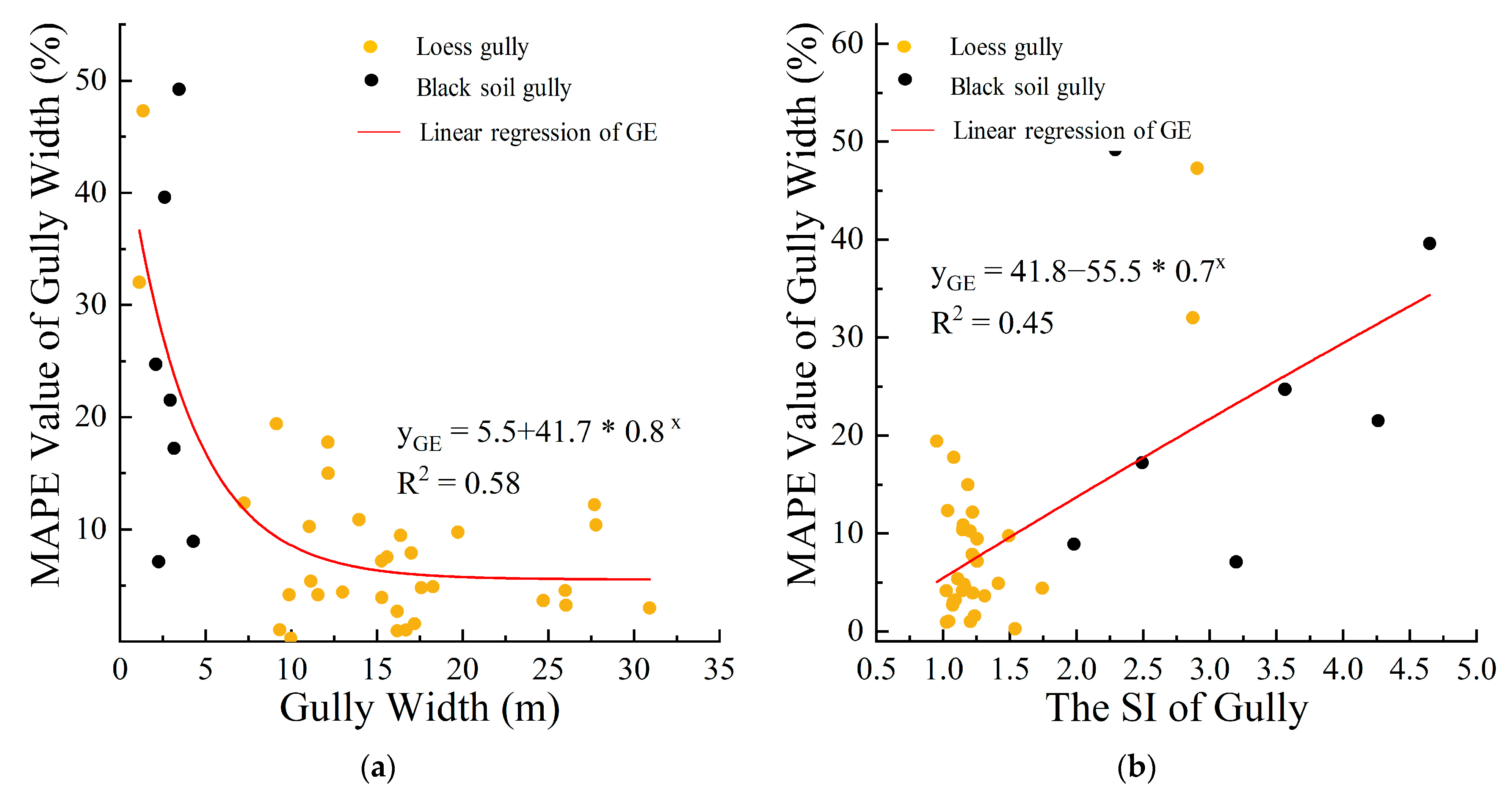
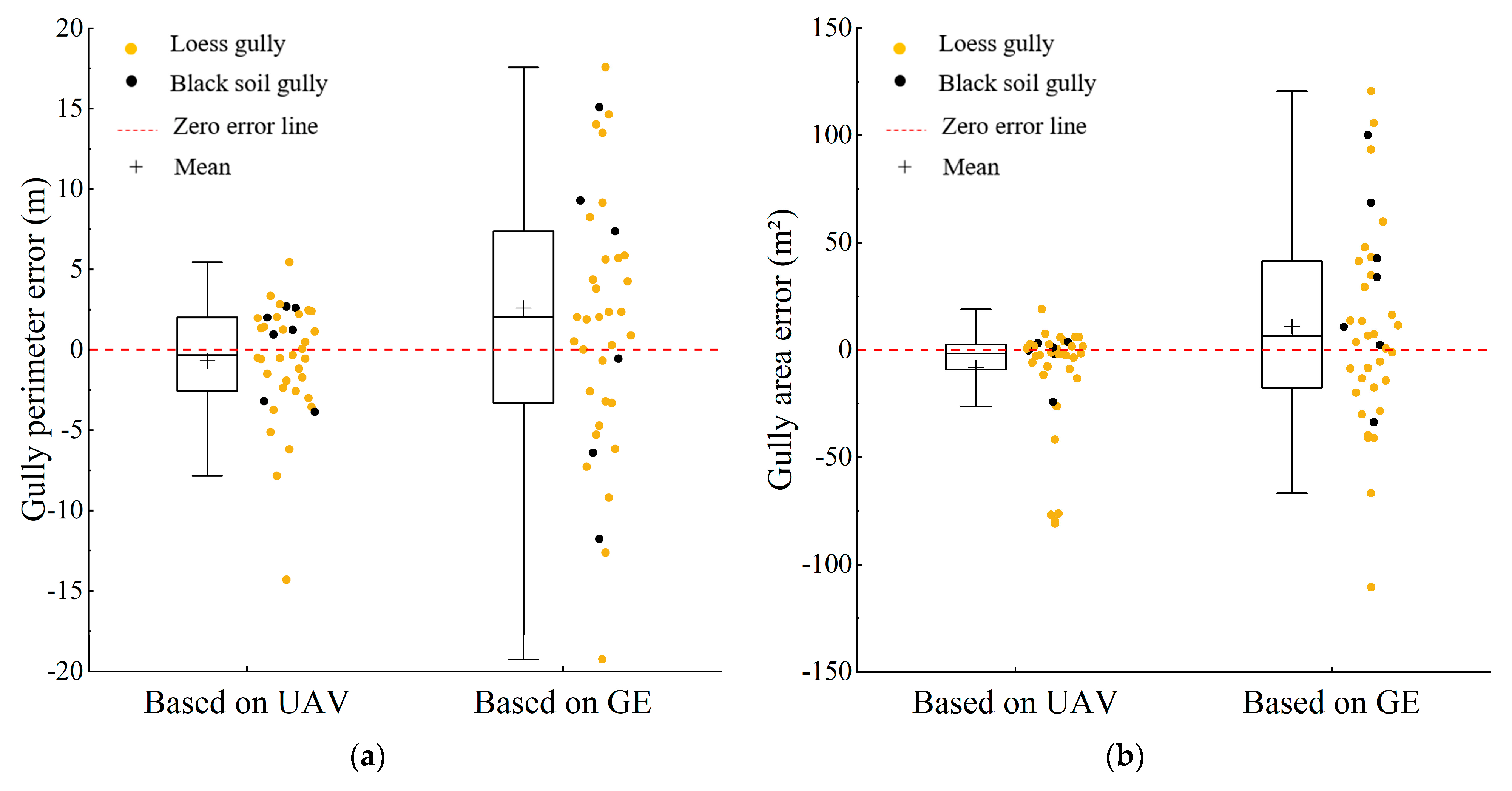

| GL/m | GW /m | GP/m | GA /m2 | GD/m | L/W | W/D | SI | CSA/m2 | ||
|---|---|---|---|---|---|---|---|---|---|---|
| Loess gully (n = 32) | Max. | 109.98 | 30.92 | 248.20 | 2213.07 | 13.47 | 32.72 | 7.08 | 2.90 | 250.97 |
| Min. | 15.17 | 1.12 | 42.10 | 37.26 | 0.18 | 1.69 | 1.05 | 0.95 | 0.14 | |
| Mean | 49.63 | 15.54 | 128.87 | 779.18 | 6.70 | 4.78 | 2.67 | 1.32 | 78.42 | |
| Black soil gully (n = 7) | Max. | 206.10 | 4.28 | 431.48 | 538.69 | 1.13 | 79.23 | 11.61 | 4.65 | 2.34 |
| Min. | 45.15 | 2.09 | 108.12 | 114.22 | 0.37 | 11.75 | 2.44 | 1.98 | 0.72 | |
| Mean | 92.88 | 2.97 | 208.78 | 254.31 | 0.73 | 33.99 | 4.91 | 3.20 | 1.27 |
| Based on UAV | Based on GE | |
|---|---|---|
| Loess gully/m (n = 32) | 0.87 | 1.71 |
| Black soil gully/m (n = 14) | 0.21 | 3.72 |
| All gullies/m (n = 46) | 0.67 | 2.32 |
| Number | Value (m) | MAE | MSE | RMSE | NSE | MAPE (%) | |||
|---|---|---|---|---|---|---|---|---|---|
| Gully Length | UAV | Loess gully | 32 | 49.67 | 0.32 | 0.17 | 0.41 | 0.99 | 0.79 |
| Black soil gully | 7 | 93.02 | 0.24 | 0.11 | 0.33 | 0.99 | 0.35 | ||
| All gullies | 39 | 57.39 | 0.30 | 0.16 | 0.40 | 0.99 | 0.71 | ||
| GE | Loess gully | 32 | 49.82 | 1.32 | 2.80 | 1.67 | 0.99 | 3.39 | |
| Black soil gully | 7 | 91.86 | 2.03 | 13.53 | 3.68 | 0.99 | 3.81 | ||
| All gullies | 39 | 57.37 | 1.45 | 4.73 | 2.17 | 0.99 | 3.46 | ||
| Gully Width | UAV | Loess gully | 32 | 15.53 | 0.31 | 0.22 | 0.47 | 0.99 | 2.38 |
| Black soil gully | 7 | 2.56 | 0.08 | 0.01 | 0.10 | 0.99 | 3.80 | ||
| All gullies | 39 | 13.20 | 0.27 | 0.18 | 0.42 | 0.99 | 2.63 | ||
| GE | Loess gully | 32 | 15.23 | 1.03 | 1.68 | 1.30 | 0.97 | 8.86 | |
| Black soil gully | 7 | 2.90 | 0.58 | 0.49 | 0.70 | 0.64 | 24.05 | ||
| All gullies | 39 | 13.02 | 0.96 | 1.47 | 1.21 | 0.98 | 11.59 |
| Number | Value (m) | MAE | MSE | RMSE | NSE | MAPE (%) | |||
|---|---|---|---|---|---|---|---|---|---|
| Gully Perimeter | UAV | Loess gully | 32 | 127.74 | 2.48 | 9.51 | 3.08 | 0.99 | 2.27 |
| Black soil gully | 7 | 210.08 | 2.54 | 8.21 | 2.87 | 0.99 | 1.43 | ||
| All gullies | 39 | 142.52 | 2.49 | 9.27 | 3.04 | 0.99 | 2.12 | ||
| GE | Loess gully | 32 | 131.45 | 6.13 | 60.56 | 7.78 | 0.98 | 5.25 | |
| Black soil gully | 7 | 211.41 | 13.05 | 361.93 | 19.02 | 0.98 | 6.85 | ||
| All gullies | 39 | 145.81 | 7.37 | 114.65 | 10.71 | 0.98 | 5.53 | ||
| Gully Area | UAV | Loess gully | 32 | 770.30 | 17.07 | 959.41 | 30.97 | 0.99 | 2.72 |
| Black soil gully | 7 | 248.98 | 5.79 | 108.60 | 10.42 | 0.99 | 1.83 | ||
| All gullies | 39 | 676.73 | 15.05 | 806.70 | 28.40 | 0.99 | 2.56 | ||
| GE | Loess gully | 32 | 784.14 | 34.96 | 2229.06 | 47.21 | 0.99 | 7.22 | |
| Black soil gully | 7 | 292.69 | 38.39 | 2722.40 | 52.18 | 0.94 | 15.24 | ||
| All gullies | 39 | 695.93 | 35.58 | 2317.61 | 48.14 | 0.99 | 8.66 |
Disclaimer/Publisher’s Note: The statements, opinions and data contained in all publications are solely those of the individual author(s) and contributor(s) and not of MDPI and/or the editor(s). MDPI and/or the editor(s) disclaim responsibility for any injury to people or property resulting from any ideas, methods, instructions or products referred to in the content. |
© 2023 by the authors. Licensee MDPI, Basel, Switzerland. This article is an open access article distributed under the terms and conditions of the Creative Commons Attribution (CC BY) license (https://creativecommons.org/licenses/by/4.0/).
Share and Cite
Zhang, C.; Wang, C.; Long, Y.; Pang, G.; Shen, H.; Wang, L.; Yang, Q. Comparative Analysis of Gully Morphology Extraction Suitability Using Unmanned Aerial Vehicle and Google Earth Imagery. Remote Sens. 2023, 15, 4302. https://doi.org/10.3390/rs15174302
Zhang C, Wang C, Long Y, Pang G, Shen H, Wang L, Yang Q. Comparative Analysis of Gully Morphology Extraction Suitability Using Unmanned Aerial Vehicle and Google Earth Imagery. Remote Sensing. 2023; 15(17):4302. https://doi.org/10.3390/rs15174302
Chicago/Turabian StyleZhang, Chunmei, Chunmei Wang, Yongqing Long, Guowei Pang, Huazhen Shen, Lei Wang, and Qinke Yang. 2023. "Comparative Analysis of Gully Morphology Extraction Suitability Using Unmanned Aerial Vehicle and Google Earth Imagery" Remote Sensing 15, no. 17: 4302. https://doi.org/10.3390/rs15174302








